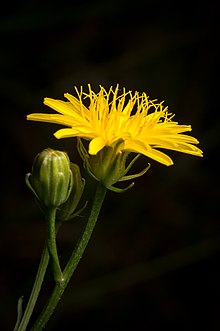| Crepis vesicaria subsp. taraxacifolia | |
|---|---|

| |
| Scientific classification | |
| Kingdom: | Plantae |
| Clade: | Tracheophytes |
| Clade: | Angiosperms |
| Clade: | Eudicots |
| Clade: | Asterids |
| Order: | Asterales |
| Family: | Asteraceae |
| Genus: | Crepis |
| Species: | C. vesicaria |
| Subspecies: | C. v. subsp. taraxacifolia |
| Trinomial name | |
| Crepis vesicaria subsp. taraxacifolia (Thuill.) Thell. | |
Crepis vesicaria subsp. taraxacifolia, the beaked hawksbeard, is a subspecies of flowering plant in the family Asteraceae. It is native to Europe and northwest Africa. It has become naturalized in scattered locations in the United Kingdom, North America, and Oceania.
Description
Crepis vesicaria subsp. taraxacifolia reaches 4 ft (120 cm) in height, with each of many branches producing yellow, dandelion-like flower heads at the tips.
At the base of the plant are long leaves 4 to 14 in (10 to 36 cm). Smaller leaves connect directly to the stem. Leaves are irregularly and deeply lobed.
The underside of each flower head has two layers of leaf-like phyllaries. The inner phyllaries are longer and pointed, and often curl back away from the flower head. The outer layer of phyllaries is substantially shorter.
References
- ^ "Crepis vesicaria subsp. taraxacifolia". Plants of the World Online. Royal Botanical Gardens Kew. Retrieved 24 May 2019.
- ^ Bogler, David (2012). "Crepis vesicaria subsp. taraxacifolia". Jepson Flora Project (eds.) Jepson eFlora.
- "Crepis vesicaria subsp. taraxacifolia". New Zealand Plant Conservation Network. Retrieved 23 May 2019.
| Taxon identifiers | |
|---|---|
| Crepis vesicaria subsp. taraxacifolia |
|
| Crepis taraxacifolia | |